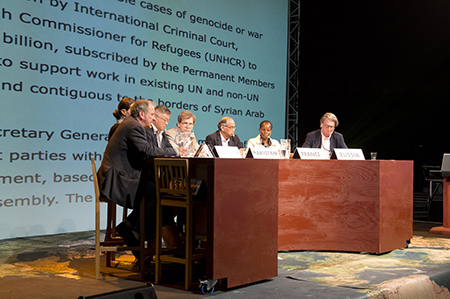
The fictional “Tällberg Security Council” meets on the opening day of the 2013 Tällberg Forum. Photo by Hans Wassaether
Every year, leaders from the academic, business and philanthropic worlds gather in northern Sweden at the Tällberg Forum to focus on different aspects of the question: “How on Earth Can We Live Together?”
The format of the meetings—organized by the Tällberg Foundation—offers an answer to that question in itself: speeching and preaching is discouraged, making time instead for orchestrated small group discussion and one-on-one exchanges and some core, shared experiences via plenaries. There is no choir at Tällberg.
I will confess that before I arrived, I had wondered whether this year’s theme, “The world at a crossroads: Making sense of globalization,” would spark much extraordinary thinking or have much relevance to us as a community of journalists. A few days with my fellow attendees in this exquisite, intimate setting proved otherwise.
On the very first day of the forum, one participant made the simple statement that we are overcrowded, interdependent and hyper-connected these days. No big shockers there. But that moved into a discussion regarding the conflict and distress that exists between our national political structures and our transnational challenges as a human community. As a journalist and a business owner, that resonated with my experience and got my attention.
One of the speakers then noted that our social, natural and institutional systems could be compared to the human body—highly interconnected and interdependent. This led to a rich discussion around where, how and when to intervene, and to what effect? And this conversation, while intellectual, was not happening in the abstract. Academic, corporate and government leaders stood openly discussing their strategies for intervention, what is working for them and what is not.
The comparison of our world to the human body was picked up by many participants and woven into the discussions. Engaged, I listened and couldn’t help but feel that if our systems and institutions are an interdependent body, then perhaps media (in the widest sense) and journalism are like water coursing through the body’s cells. If you cut open a human body you will not find “water” per se, and if you dissected the human global structures you wouldn’t find “media,” and yet if you are one of the billions of people on the planet who live with even fairly reliable electricity, media permeates everything that we experience and do. It shapes how we think of ourselves, our social communities, our roles and responsibilities and can even define what we believe is possible. It shapes our perceptions of each other, our institutions, our challenges and our opportunities. Rarely do individuals have the energy, time or interest to think or question beyond the frame in which the media presents the world to them. By media I include a wide swath of entertainment and fictional creations, which can be as powerful and influential as any fact-based journalism.
The media’s pervasive, even insidious, capacity to shape our thinking leads me to ask what role journalism plays in serving the human community. What responsibility does journalism—and individual journalists—have as an institution to shape what we think about our world? My thinking, which has been reinforced through the Tällberg Forum, is that we as journalists have a responsibility to ensure our work provides a constructive foundation for people to grasp the world around them, helps them recognize, manage, and hopefully further study this situation, and take action around our collective interdependence.
Journalism’s audience and content have always been shaped by the available technology. A newspaper’s circulation was once determined by how far a horse and buggy could travel between the time the presses stopped and 7 a.m. Radio and television allowed reach to expand, and the business model and storytelling structures adjusted to the new technology, a shift that took significant time. Today we are in the early years of a new medium, and, as before, it is taking journalism time to understand the revenue model and storytelling power of the digital medium.
For the first time in history, journalism’s reach is now truly unfettered. With the opportunity to reach a vast, global audience comes a responsibility to provide content that informs a global community, revealing to us the interdependent nature of our world. But our journalism content, our message, has yet to catch up with the opportunity and power of the digital medium.
I would argue that the status quo in journalism today sees, describes and reveals the world to our audience as a set of discreet, unique communities. This status quo simply perpetuates the conceit that we live in separate communities, with separate challenges, opportunities and futures. Hence, we as journalists play a role in shielding our audience from the potentially uncomfortable reality of our interdependence, the fact that our futures are intertwined and our lives are tightly interwoven.
So, the point is not to place blame on journalism and journalists for the worlds’ ills; we are simply an evolving institution within a wider set of evolving institutions. But we have the capacity to be an effective game changer, to grease the skids of collaboration and coordination by facilitating the public’s vision of self and others as interdependent as our human community wrestles with these transnational twins of opportunity and peril. If we are, to continue the metaphor, the water in the body of the global systemic structure, what might we do as individuals, as journalism organizations, and as part of a larger social institution of media to facilitate the recognition of the world we live in as interdependent and interconnected?
Molly Bingham, NF ’05, is the president and CEO of ORBmedia, a nonprofit journalism organization based in Washington, D.C.

